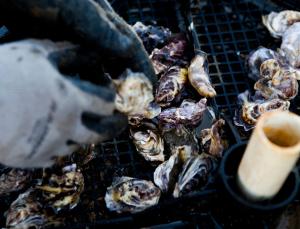Posted on New Scientist-Environment: 14 Jun 2013 — By Colin Barras

Succeeding in growth (Image: Sam Hodgson/Bloomberg via Getty Images)
Bad news for oyster lovers. As the ocean acidifies, oyster larvae are struggling to build their shells, reducing the number that reach adulthood. We already knew that acidifying oceans spell trouble for many marine species: the shells of some marine snails in the Southern Ocean have already begun to dissolve. But now there is evidence that some creatures are under threat just when they need it least – as they are trying to form their protective shells.
The Pacific Northwest oyster harvest has been disappointing for the last few years. One possible explanation comes from recent studies that show oyster larvae are significantly less likely to survive as seawater pH falls. To find out why, George Waldbusser‘s team at Oregon State University in Corvallis studied oyster larvae during their first three weeks of development.
They discovered that the tiny larvae undergo a dramatic growth spurt during their first 48 hours of life, forming new shell at a rate 10 times higher than they do when they are five days old.
This spurt is fuelled by nutrients packed into each larva’s egg. As well as powering shell construction, the nutrients also fuel the development of feeding organs – vital for getting energy once the food source from the egg has been used up. But such high growth rates are difficult to sustain when seawater pH falls. That’s because the carbonate ions normally used to build calcium carbonate shells instead react with the more acidic water, reducing the amount available for shell material.
The next wave
The study is an “excellent example of the next wave of research into the effects of ocean acidification”, says Geraint Tarling at the British Antarctic Survey in Cambridge, UK. Researchers are now going beyond simply documenting which species are vulnerable to acidification, he says, and instead asking why and when the problems will emerge.
The findings suggest a way for commercial oyster hatcheries to intervene and boost their stocks: adding a chemical buffer to increase seawater pH levels during the crucial first few days of oyster growth.
That kind of intervention is more difficult in the wild, although reducing coastal pollution can dampen the effects of acidification. “Ultimately, reducing carbon dioxide emissions is needed,” he says.
Journal reference: Geophysical Research Letters, doi.org/mts
Read this article on New Scientist